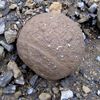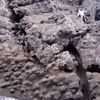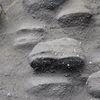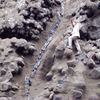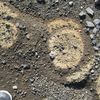Fęrsluflokkur: Menning og listir
Loomweights from Iceland and Crete
17.2.2010 | 01:07
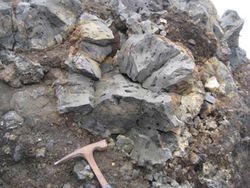 In the spring of 2009 I was visiting my neighbor in Stykkishólmur, Einar. He is a great rock collector, and most of the big rocks are outside, in the garden, perhaps at his wife“s request. I immediately spotted a basalti rock which was puncured through by narrow pipe-like holes, as if it had ben drilled. “Where did you find it?” I asked. “It is from the seacliffs of Mķgandi waterfall at the farm of Kljį” he said. Mķgandi in Icelandic means the pisser. Two strange names: Mķgandi and Kljį. It reminded me of the story of my grandfather, Oddur Valentķnusson, the harbor pilot of Stykkishólmur for many years. It was in the summer of 1941, which was so dry that al the wells in the village dired up. My grandfather took a huge sail and spread it over the deck of his boat Gola, and sailed it up undr the waterfall of Mķgandi, where the waterfall plunges directly into the sea. When the boat was nearly full of water, he put the engine in reverse and motored back home with a boatful of fresh water for the home. The next day Einar and I hiked to the waterfall to study the rock formation where the rocks with the holes came from. I saw that this was pillow lava, or lava that has formed by flowing into the ocean. The photo to the left shows one of the pillows.
In the spring of 2009 I was visiting my neighbor in Stykkishólmur, Einar. He is a great rock collector, and most of the big rocks are outside, in the garden, perhaps at his wife“s request. I immediately spotted a basalti rock which was puncured through by narrow pipe-like holes, as if it had ben drilled. “Where did you find it?” I asked. “It is from the seacliffs of Mķgandi waterfall at the farm of Kljį” he said. Mķgandi in Icelandic means the pisser. Two strange names: Mķgandi and Kljį. It reminded me of the story of my grandfather, Oddur Valentķnusson, the harbor pilot of Stykkishólmur for many years. It was in the summer of 1941, which was so dry that al the wells in the village dired up. My grandfather took a huge sail and spread it over the deck of his boat Gola, and sailed it up undr the waterfall of Mķgandi, where the waterfall plunges directly into the sea. When the boat was nearly full of water, he put the engine in reverse and motored back home with a boatful of fresh water for the home. The next day Einar and I hiked to the waterfall to study the rock formation where the rocks with the holes came from. I saw that this was pillow lava, or lava that has formed by flowing into the ocean. The photo to the left shows one of the pillows. 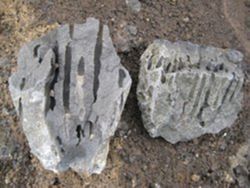 Under these conditions, the seawater boils below the hot lava flow and creates seam which expands and breaks a path up through the molten lava flow and leaves behind narrow pipes in the lava as it solidifies. The first thing that came to mind was loomweights when I saw these stones, which were all perforated with long pipe-like holes. The whole beach was littered with them. Later I found out that this lava had flowed from Hafrafell volcano on Snęfellsnes during the last interglacial period, probably about one hundred years ago. But what are loomweights? They are stones that are used to weigh down or stretch the loom during weaving. In Icelandic they are kalled kljįsteinar. But wait a minute! That is the name of the farm above the locality where we had just found these strange and beautiful rocks with the pipes! I was familiar with loomweights through my work in Crete in the Aegean Sea. Working in the Bronze age coastal deposits of Crete in 2007 and 2008, I discovered several loomweights that had ben caught in the tsunami or tidal wave that was generated during the great eruption of Santorini.
Under these conditions, the seawater boils below the hot lava flow and creates seam which expands and breaks a path up through the molten lava flow and leaves behind narrow pipes in the lava as it solidifies. The first thing that came to mind was loomweights when I saw these stones, which were all perforated with long pipe-like holes. The whole beach was littered with them. Later I found out that this lava had flowed from Hafrafell volcano on Snęfellsnes during the last interglacial period, probably about one hundred years ago. But what are loomweights? They are stones that are used to weigh down or stretch the loom during weaving. In Icelandic they are kalled kljįsteinar. But wait a minute! That is the name of the farm above the locality where we had just found these strange and beautiful rocks with the pipes! I was familiar with loomweights through my work in Crete in the Aegean Sea. Working in the Bronze age coastal deposits of Crete in 2007 and 2008, I discovered several loomweights that had ben caught in the tsunami or tidal wave that was generated during the great eruption of Santorini. 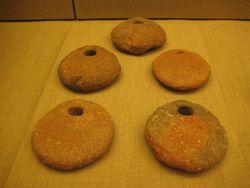 They are shown in the photo above and they are exhibited at the Volcano Museum in Stykkishólmur, Iceland. The Icelandic name for loomweights is kljįsteianr, and Kljį is the name of the farm wehre we found these stones. Is the farm“s name derived from the abundance of readymade loomweights at the beach? I think so. Such stones are rare in Iceland and this must have been a special locality in the middle ages.
They are shown in the photo above and they are exhibited at the Volcano Museum in Stykkishólmur, Iceland. The Icelandic name for loomweights is kljįsteianr, and Kljį is the name of the farm wehre we found these stones. Is the farm“s name derived from the abundance of readymade loomweights at the beach? I think so. Such stones are rare in Iceland and this must have been a special locality in the middle ages. 


